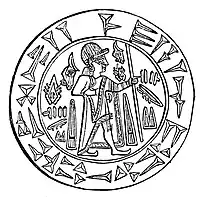
Tarkasnawa was ruler of the Kingdom of Mira, and one of the last independent kings of Arzawa, a Bronze Age confederation of kingdoms in western Anatolia. He was probably the son of King Alantalli, and a contemporary of the later king Tudḫaliya IV.[1] He was succeeded by Uhha-Ziti.
Tarkasnawa appears in the Karabel relief, where his name is inscribed in Luwian hieroglyphs. The inscription, next to the figure of the king, reads:
(King) Tarkasnawa, king of <the land> Mira,
[son] of BIRD-li(?), king of the land Mira, grandson
of [ ... ], king of the land Mir.[1]
He is also known from various seals, one of them in which his name was formerly read "Tarkondemos".[1] This is a bilingual seal, combining a cuneiform inscription on the rim and the corresponding Hittite hieroglyphs around the figure in royal dress, giving the name of the ruler: Tarkasnawa.[1] This bilingual inscription provided the first clues for deciphering Hittite hieroglyphs.

 Seal of Tarkasnawa (drawing of imprint)
Seal of Tarkasnawa (drawing of imprint).jpg.webp) Seal of Tarkasnawa: 19th-century reading of the cuneiform
Seal of Tarkasnawa: 19th-century reading of the cuneiform
References
- 1 2 3 4 5 Hawkins, J. D. (1998). "Tarkasnawa King of Mira 'Tarkondemos', Boǧazköy Sealings and Karabel". Anatolian Studies. 48: 1–31. doi:10.2307/3643046. ISSN 0066-1546. JSTOR 3643046. S2CID 178771977.
- ↑ Wright, William (1886). The Empire of the Hittites : with Decipherment of Hittite inscriptions. London : Nisbet.
